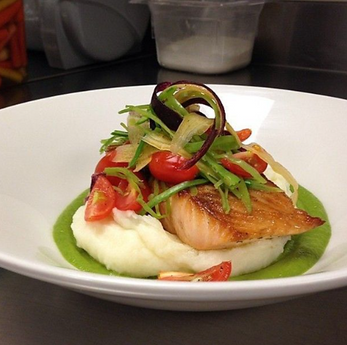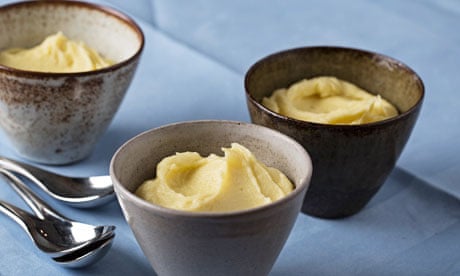"There is no wrong way to mash a potato; only multiple right ways to serve a purpose." Yotam Ottolenghi
On the left British mashed potatoes from the Sprinkles and Sprouts website and on the right Heston Blumenthal's perfect mash which sort of show the difference, between the roughly textured homey version that I grew up with and the extreme posh restaurant version of purée de pommes de terre.

I've been meaning to do a post on mashed potatoes ever since I saw Guillaume Brahimi make what he called Paris Mash in the Plat du Tour series. Because mash has become such a thing has it not? Whenever you go to a posh restaurant these days, not even a particularly posh one, your meat or fish will very often come served with mash. Which always causes a problem for us because David hates mash. It's probably something to do with his youth.
I confess I have memories of truly awful mashed potatoes in my primary school days. I think the school dinners there were cooked elsewhere and brought into the school in large metal containers. The food was mostly awful and the mashed potatoes were particularly awful. Now I loved potatoes - I always have and confess to being a bit of a potato freak, but these made me gag. I think it was the lumps of potato mixed with really mashed potato. Fortunately my mother made really good basic mashed potato like the ones in the picture above - potatoes mashed with a masher with a bit of butter and a bit of milk mixed in to help make it a bit smoother. And so I was able to overcome the trauma of the school ones. Then when I went to France a little later in my life I was served purée de pommes de terre, in which the potatoes were forced through the mouli before being beaten over the heat with lots of butter and some milk. And I just loved this. That and the soup were the reasons I bought myself a mouli very early on - maybe when I was still at school. David doesn't seem to have got over his aversion though.
I also confess that at one point in my childhood when I was around ten years old perhaps, I used to just mash everything together on my plate. Which sounds repulsive to me now but which I really liked at the time. Of course, as babies we are served mashed foods, to aid in their digestion and to get over the fact that babies don't have teeth. So maybe the love of mashed foods is a hangover from that. Ultimate comfort I guess. And whilst David does not like mashed potato, if we have a stew and I serve boiled potatoes with it he will mash the potatoes on his plate into the gravy from the stew. Go figure.
Back to the posh restaurant thing though. Now I do think that mash or purée is particularly, and possibly only, best served with a dish that has a sauce which can then be mixed with the purée. Therefore the purée should not be too thin, if that's the right word, or you just end up with something that is neither sauce nor vegetable. And I think those supremely posh versions look just too runny to me. No the mash should have some solidity so that you can taste both elements - the sauce and the potato. Mostly though restaurants seem to serve it as a base for the main event with the meat or the fish perched on top, or with the potato decoratively swirled nearby. Here are a few examples, including the obligatory bangers and mash. Fish in particular doesn't go well with mash I think and yet this is an increasingly common way of serving fish. For me fish needs chips. Steak too.

Of course if you are serving top of the line purée then you make a feature of the purée itself. The late 3 starred Michelin chef Joël Rubichon seems to be the acknowledged king of purée de pommes de terre. His recipe (click on his name) is rumoured to be half and half potatoes and butter, and takes literally hours of work to produce. But many find the amount of butter is just too much.
"Not only is the texture too silky for my taste (homemade mash should be robust stuff, I realise belatedly), but the whole episode has shaken a fundamental tenet of my existence – it turns out that, sometimes, there is such a thing as Too Much Butter. Give me a masher and a single lump over an entire packet any day." Felicity Cloake
Moreover it's hard work and it takes ages.
"I quickly decided that, like croissants and pizza, Robuchon's purée is a dish best executed in a professional kitchen: investing in something called a tamis for one recipe is not something I can justify, even to myself." Felicity Cloake

And she is not alone in expressing this opinion. Felicity Cloake's article on making the perfect mashed potato (the picture is of her finished and considered version) says much the same about Heston Blumenthal:
"I realise I have all the equipment necessary to make Heston's pomme purée. (Luckily, I also have a free evening: it takes me about three hours from start to finish.) The secret to perfect mash, he says, lies in understanding the science of the potato: you must "break down the cell walls … in a controlled way, while leaving the starch granules essentially intact" in order to avoid the dreaded wallpaper-paste effect. This, of course, requires the use of every pan in your kitchen." Felicity Cloake
So if these chefs are taking such pains with their mashed potatoes, then it's small wonder that they either take a lot of care in presenting them beautifully as a completely separate dish.
That one on the left is easy to do by the way. I saw a video of it. Just put a big blob of the purée on your carefully chosen black plate and draw a spoon through it to make that shape. Remember that for the next time you want to make something fairly runny look good on the plate.
And just as an amusing end note to the technical side of things. Felicity Cloake describes Delia's technique:
"how you mash or cream potatoes can be a personal thing," she explains, before dropping the bombshell that, "inclined to laziness myself, I use my electric hand-whisk." Delia Smith
So Felicity has a go and gets potato splattered everywhere. Others didn't - frankly I think Felicity was just a bit careless - but they do say that it makes it a bit gluey. And another thing, that can make the final result a bit gluey rather than 'smooth as silk', or creamy, is to not warm your milk before adding it. I must try that next time because I confess I just pour in a bit of cold milk.
Besides the technique you use there is also the matter of the right potato to use, and here there seems to be a divide between floury and waxy. The 'professionals' seem to go for the yellow and waxy, but it does seem to be the more difficult option:
"You can make a nice mash with a yellow waxy potato but it is a different thing altogether, and temperamental, too. Leave it to the chefs who do it so beautifully." Nigel Slater
I confess I just use what I have at the time. I never have a variety of potatoes to choose from. David is not as big a fan of potatoes as I and so it seems to me that they are an increasingly rare component of our meals - more often it's rice or pasta. When I was visiting the market I might buy two, sometimes even three different kinds of potatoes, but no longer.
These days of course we mash all sorts of other things, and add all sorts of things to our potato mash other than milk and butter. Hugh Fearnley-Whittingstall has a really good list to get you started with ideas of how to tart up your mash and a few choice words on the subject too.
"we're now bashing up all kinds of roots as never before, not just the humble spud, but parsnips, swede, celeriac, sweet potato and Jerusalem artichokes. And we're adding all sorts to the mix, from goat's cheese and creme fraiche to shallots, spring onions, garlic and horseradish." Hugh Fearnley-Whittingstall
There are also, of course, endless things that you can do with mashed potato - and I might look at that tomorrow - later anyway, but I will leave you with two really interesting ideas from Yotam Ottolenghi - Potato spirals with tomato salsa and creme fraiche and Riced potatoes with anchovy butter. In the first the mashed potato is made into a dough with polenta, baked until crispy, rolled up and cut into bite sized pieces, and the in the second the riced potatoes are left riced and topped with a melted anchovy butter fried sage leaves and some cream.
Interesting but not especially simple - particularly the spirals. We have friends coming for lunch on Wednesday - maybe I'll give the spirals a go.


















Comentários